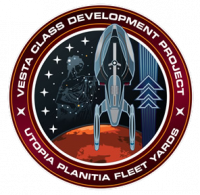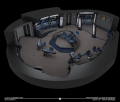Difference between revisions of "Vesta Class"
m |
m |
||
| (6 intermediate revisions by the same user not shown) | |||
| Line 1: | Line 1: | ||
| − | + | __NOEDITSECTION____NOTOC__ | |
| − | |||
{{Sidebar\starship | {{Sidebar\starship | ||
| ship name = Vesta-class Explorer | | ship name = Vesta-class Explorer | ||
| Line 10: | Line 9: | ||
| specifications = | | specifications = | ||
}} | }} | ||
| + | ===Overview=== | ||
| − | The Vesta-class | + | The ''Vesta-class'' Explorer represents the epitome of late 24th-century engineering. Designed as a long-range vessel of exploration, the Vesta built off the success of the ''[https://memory-alpha.fandom.com/wiki/Dauntless_class Dauntless class]'' of the early 2380s and equipped with Starfleet's first production [[Quantum Slipstream Drive]]. Equipped with state-of-the-art technologies, the ''Vesta-class'' starship is often assigned to deep-space exploration and reconnaissance missions and is therefore rarely seen within Federation Space. Only a limited number were completed prior to the destruction of Utopia Planitia in 2385, which many believed would be the end of the project, but production was distributed to other shipyards around the Federation and new ships began launching in the early 2390s. Nearly the entire production run was assigned to explore beyond the boundaries of Federation space, though a handful were retained for special duties. |
| − | |||
| − | |||
| − | |||
| − | |||
| − | The | + | The rarity of the ''Vesta-class'' Explorer and its scarcity within the Federation's borders has led some to consider crews an elite bunch even among Starfleet; competition for space aboard such a vessel is fierce and only the best and the brightest are assigned. Service on a deep-space assignment aboard a ''Vesta-class'' is seen by many as a guarantee of promotion to higher position, though obviously these positions are not without their risks... |
| − | + | ===Capabilities=== | |
| − | + | The ''Vesta-class'' was the culmination of decades of Research and Development combined with a few chance discoveries from the Delta Quadrant; prime among these being the Quantum Slipstream Drive. The ''Vesta-class'' also includes second-generation Bio-Neural Gel Packs and the most modern computer and sensor systems to emerge from the Daystrom Institute. This gives it unparalleled capacity as a long-range explorer, especially when combined with the impressive capacity for carrying cargo and auxiliary craft - a single ''Vesta-class'' and its auxiliary craft can survey an entire system in half the time another Starfleet vessel would take. | |
| − | + | Exploring deep space has its dangers, and the ''Vesta-class'' is more than capable of meeting those dangers head-on. With primary and secondary Impulse Engines, it is able to outmaneuver or outrun most ships at sublight speeds, and what it cannot outrun its impressive armament usually allows it to out-shoot. Combat is not, however, the specialty of the ''Vesta-class'', requiring Captains to pick their battles and when forced to engage, to disable or destroy their opponent quickly before making a rapid getaway. | |
| − | + | ===Mission Profiles=== | |
| − | + | ''Vesta-class'' starships are usually assigned to deep-space exploration missions, as a diplomatic/First Contact vessel, or as technical testbeds for new technologies. | |
| − | |||
| − | |||
| − | |||
| − | |||
<gallery> | <gallery> | ||
| Line 41: | Line 33: | ||
</gallery> | </gallery> | ||
| − | === Vessels of Note=== | + | === Vessels of Note === |
| − | + | ||
| − | {| | + | {| width="50%" style="background: transparent" |
| − | ! | + | ! colspan="3" style="background:maroon;"|Vesta-class Explorers |
| − | | | ||
| − | |||
| − | |||
| − | |||
| − | |||
| − | |||
| − | |||
| − | |||
|- | |- | ||
| − | | '' | + | |USS ''Vesta'', NCC-82601 <ref>Prototype</ref> || USS ''Aventine'', NCC-82602 || USS ''Caelian'', NCC-82611 <ref>Assigned to Starfleet Intelligence</ref> |
|- | |- | ||
| − | | '' | + | |USS ''Capitoline'', NCC-82611 || USS ''Esquiline'', NCC-82614 <ref>Missing</ref> || USS ''Quirinal'', NCC-82610 <ref>Missing</ref> |
|- | |- | ||
| − | | ''USS | + | |[[USS Artemis, NCC-110000|USS ''Artemis'', NCC-110000]] || [[USS Freyja, NCC-82613|USS ''Freyja'', NCC-82613]] || |[[USS Nike, NCC-82612|USS ''Nike'', NCC-82612]] |
|- | |- | ||
| − | | ''USS | + | |USS ''Palatine'', NCC-60067 || USS ''Athena'', NCC-82621 || ''USS Viminal'', NCC-82626 |
|- | |- | ||
| − | | | + | | |
| − | |||
| − | |||
| − | |||
| − | |||
| − | |||
| − | |||
|} | |} | ||
| + | |||
[[Category: Starship]][[Category: Engineering]] | [[Category: Starship]][[Category: Engineering]] | ||
Latest revision as of 00:42, 31 March 2024
| STARSHIP | |
|---|---|
 | |
| Class | Vesta Class Explorer |
| Allegiance | United Federation of Planets |
 | |
 | |
| Specifications | |
| Type: | Explorer |
| Length: | 670 Meters |
| Beam: | 195 Meters |
| Height: | 88 Meters |
| Mass: | 3,321,630 metric tons |
| Decks: | 19 Deck Plans |
| Crew Compliment: | Standard: 115 Officers, 485 Enlisted Crew Breakdown Emergency: 2,000 |
| Warp Speed: | Type: Cruise Speed: Warp 8 Sustainable Speed: Warp 9.8 Emergency Speed: Warp 9.99 (36 hour automatic shutdown) |
| Impulse Engines: | Type: 2 Class 8 Main Impulse Engines (MIE), 2 Secondary Impulse Engines (SIE) Speed: .87 C |
| Other Propulsion Systems: | Rigel Labs X04 Quantum Slipstream Generator Speed: Warp 9.99998477 (12 hour automatic shutdown) |
| Defensive Systems: | Type-1A Shield generator |
| Other Defensive Systems: | Sensor Cloak, 20cm Ablative Armour |
| Armament: | Phasers: 2x Type XII Phaser Cannons (Saucer - Forward); 2x 140-degree Type-XII Arrays, one starboard, one port (Saucer - Dorsal); 2x 90-degree Type-XII Arrays, one starboard, one port (Saucer - Ventral); |
| Other Capabilities: | Planet Landing Capabilities - Blue Alert |
| Computer System: | Yori-Moto D4D019 |
| Tractor/Repulsor: | 2 Main Tractor/Repulsor Beams, 5 Shuttle Docking Tractors (4 in Main Bay, 1 for Yacht), 6 Docking Tractors |
| Shuttlecraft: | 1 Bay (A), 10 Shuttles (4 Type 12, 4 Type 14, 2 Type 17), 2 Runabouts (Delta Class) |
| Sensors: | SS Sierra 1a8 Deep Space Scientific Sensors Daystrom Industries HSCS-3SC-A Starship Sensors |
Overview
The Vesta-class Explorer represents the epitome of late 24th-century engineering. Designed as a long-range vessel of exploration, the Vesta built off the success of the Dauntless class of the early 2380s and equipped with Starfleet's first production Quantum Slipstream Drive. Equipped with state-of-the-art technologies, the Vesta-class starship is often assigned to deep-space exploration and reconnaissance missions and is therefore rarely seen within Federation Space. Only a limited number were completed prior to the destruction of Utopia Planitia in 2385, which many believed would be the end of the project, but production was distributed to other shipyards around the Federation and new ships began launching in the early 2390s. Nearly the entire production run was assigned to explore beyond the boundaries of Federation space, though a handful were retained for special duties.
The rarity of the Vesta-class Explorer and its scarcity within the Federation's borders has led some to consider crews an elite bunch even among Starfleet; competition for space aboard such a vessel is fierce and only the best and the brightest are assigned. Service on a deep-space assignment aboard a Vesta-class is seen by many as a guarantee of promotion to higher position, though obviously these positions are not without their risks...
Capabilities
The Vesta-class was the culmination of decades of Research and Development combined with a few chance discoveries from the Delta Quadrant; prime among these being the Quantum Slipstream Drive. The Vesta-class also includes second-generation Bio-Neural Gel Packs and the most modern computer and sensor systems to emerge from the Daystrom Institute. This gives it unparalleled capacity as a long-range explorer, especially when combined with the impressive capacity for carrying cargo and auxiliary craft - a single Vesta-class and its auxiliary craft can survey an entire system in half the time another Starfleet vessel would take.
Exploring deep space has its dangers, and the Vesta-class is more than capable of meeting those dangers head-on. With primary and secondary Impulse Engines, it is able to outmaneuver or outrun most ships at sublight speeds, and what it cannot outrun its impressive armament usually allows it to out-shoot. Combat is not, however, the specialty of the Vesta-class, requiring Captains to pick their battles and when forced to engage, to disable or destroy their opponent quickly before making a rapid getaway.
Mission Profiles
Vesta-class starships are usually assigned to deep-space exploration missions, as a diplomatic/First Contact vessel, or as technical testbeds for new technologies.
Vessels of Note
| Vesta-class Explorers | ||
|---|---|---|
| USS Vesta, NCC-82601 [1] | USS Aventine, NCC-82602 | USS Caelian, NCC-82611 [2] |
| USS Capitoline, NCC-82611 | USS Esquiline, NCC-82614 [3] | USS Quirinal, NCC-82610 [4] |
| USS Artemis, NCC-110000 | USS Freyja, NCC-82613 | USS Nike, NCC-82612 |
| USS Palatine, NCC-60067 | USS Athena, NCC-82621 | USS Viminal, NCC-82626 |




